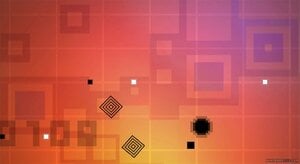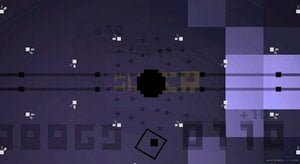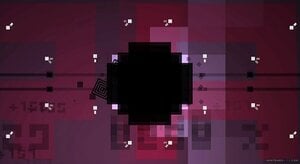
Gaijin Games has really earned a place in many a retro-gaming fan's heart with their old, old-school Bit.Trip series on WiiWare. It's one of the shining examples of how good download games can really be: updated Atari 8-bit graphics with jazzed-up special effects and a soundtrack that's enhanced by the gameplay.
The appeal of these games is cross-border, which is aptly demonstrated by the premiere launch of the third entry, Bit.Trip VOID on the Japanese WiiWare service by Arc System Works. As with other Bit.Trip games the in-game text is all in English making it both retro and gaijin-friendly for importers who don't read much Japanese, though this game is a bit more oblique than previous entries in its basic controller requirements and menu navigation. You're never prompted to connect a Nunchuk - though the game does require it - and there's no feedback in the menus, so unless you know you need one you can sit there for a bit looking the doofus pressing buttons and such until you think to try connecting one and then you'll realise that this is the first Bit.Trip game which uses the analogue stick. You move the titular VOID to select the stage to start, High Score table or Credits and you need to ensure you're covering the black dot next to the selection before pressing A to begin.

Bit.Trip VOID plays very much like a non-violent version of Ikaruga: you control a black pixellated dot and try to absorb other black dots by moving into them, whilst avoiding the white dots. Dots move across the screen from various directions in a variety of patterns; it's important not to miss any black dots and not to hit any white ones, as both of these will result in your descent into the tuneless and colourless Nether region before ending the game (hitting white dots also loses you 1000 points a shot - ouch!) Complicating matters is the fact that the VOID keeps on growing as you collect more black dots, whilst hitting white dots shrinks it back down to its original size, though that's not a good thing. Thankfully you can shrink the Void yourself by pressing the A button, minus the penalties, which adds an additional strategic element to the gameplay.
Folk who found the previous two games punishingly difficult will find this one a refreshing attempt to broaden appeal, with VOID possessing not only three checkpoints per stage but also the option to continue from the last checkpoint in the event that you fail. That doesn't make the game any easier though: given the penalties for missing black dots and hitting white ones your game can end in a matter of seconds quite easily. On top of that your score will reset in the event you continue and given you need at least one million points to get your name on the board, making it a tough choice whether to continue or not.

The special effects in the game are quite impressive: there are different types of black and white dots and they move in formations, making it clear this is NOT an 8-bit Atari 2600 game however much it may superficially appear to be. Periodically special events will be marked by on-screen text announcing REPULSION (for a limited time the VOID repels white dots) and VORTEX (for a limited time the VOID attracts black dots) which add spice to the proceedings.
The soundtrack is full of very pleasing chiptunes-style tracks, though the more free-form gameplay means that hitting the dots doesn't necessarily contribute as much to the music as in previous games. Gaijin has thoughtfully given the B button the ability to add notes to the song freestyle, so you can tap away and add to the music whilst moving your VOID about as you see fit. It's a fun addition that really makes VOID stand out from the previous two entries in the series and it's nice to see Gaijin Games still has that magic touch!
Comments 42
I can't WAIT to play this one.
Looks great. Hopefully we'll see this on Monday.
Well, actually even in Beat and Core pressing the other buttons played some freestyle notes...
Cool -- hope we get this Monday. How does the 4-player mode work?
@NikeXTC -- Really? I had no idea. Wow now I need to play those again too!
I didn't get a chance to play with multiplayer; I knew from watching Nintendo Week that two-player was available, but had no idea you could play with 4! We gotta leave something for the full review ya know!
I loved BEAT, but didn't think CORE looked fun at all. The fact that this plays a lot like Ikaruga, makes me extremely interested...probably worth a download.
Great batch of First Impressions this week, Sean.
...you lucky &^!#$@#$.
@Sean Aaron -- yup this feature has always been there
can't wait for this to hit europe... in 2010
i titally mastered CORE but still need to finish beat.
Bit.Trip Core was much less interesting than Beat for me... but Void looks really good again. Can't wait for release.
please come this monday, please come this monday
I'm getting this when it comes out!
When I complete Beat, I may skip Core entirely, as this looks a lot better.
These guys have not missed a beat yet (), Core was a great experience as the later levels actually gave you little second chances and ways to alter the soundtrack as certain bits would eventually cross 2 axises before leaving the screen, and the bosses were fantastic.
This one does look to be the best of the series though. I'm so stoked.
The first two bit trip games also had the freestyle music feature Sean, you're slipping
That was covered in posts 3, 5 and 8, accc. You're slipping too.
Thanks for the nice write-up, Sean! One clarification though: the game tells you to connect a Nunchuk (or Classic Controller--FTW!) during the boot sequence. I can't wait for the review to see what y'all think!
Wow 1 million points to just hit the high score. must make it even easier to get points like in core. I wonter if in bit.trip 4 if we will need to get 500 mil to reach high score
@joeshabadoo:
You're right: Gaijin Games hasn't missed yet. My earlier comment might've sounded too harsh. Core is still one of my favorite WiiWare games... it only falls short when you compare it to the total awesomeness of Beat.
@CommanderVideo:
Classic controller support? Awesome.
Sounds like DCSquares, a Mac/Windows/Dreamcast/iPhone game.
@CommanderVideo: I usually gloss over the standard Wii controller screens. In order to get me to plug in the nunchuk I need the game to stop and say "Plug in the Nunchuk to Continue." I even checked the ops manual, but didn't see any katakana for it, but that's cool. Why no NES-style remote support?
Though I respect the series, I have retired myself from this series. Have a good one guys.
@sean
NES-Style ---> no analogue. i can't imagine playing this this just with the d-pad
I guess i should give it a go, This is series is insanely popular. I just couldn't find anything interesting in it.But hey, it could be fun.
option to continue from the last checkpoint in the event that you fail
thank you for listening to your fans, GG!
@Machu: if you skip Core, you're missing out, just sayin'. Control was an awesome song.
Is there any chance of this making it to Europe this week?
i haven't been into the bit games but i may get this one
@NeoRauch: Why not? I don't see how analogue a requirement for this game at all; I'd really rather use a d-pad.
@ejamer
Haha,your only saying that because commandervideo came on and left a comment.Admit it,you didnt like it!
@Sean
I really dont know how you missed the ability to play freestyle in beat,its the first thing you notice.Cant comment on core because i've not got it but i'd imagine its blatantly obvious too.Aren't reviewers meant to notice these things?
I'm not reviewing the game, note the words FIRST IMPRESSIONS in the title?
I never noted it in the other games because pressing the A and B buttons aren't relevant to the gameplay otherwise and I'm too busy trying to stay alive to do that. VOID has a more leisurely pace and the more conventional remote grip lent itself better to experimentation of that sort.
lol poor sean
Judging by the video I saw on youtube it seems like the pointer would be a better control option for this game than d-pad or analog movement, although it might make it too easy.
@wiiwii:
"I really dont know how you missed the ability to play freestyle in beat,its the first thing you notice."
Being as he managed to play both games without noticing it, I'd say the claim that freestyle-jammin' is the "first thing you notice" is somewhat fallacious.
It's also not a necessity for playing, completing, or even enjoying the game, so I'm not sure how this is meant to factor into Sean's capacity for reviewing things...but hey, what do I know? I'm just a simple hyperchicken.
Commander Video, will you marry me? It's not legal in my home state, but I'm willing to move. For you.
@Adam: no cutsies! get in line like the rest of us. >:/
@Sean
I didnt say you were reviewing it but thats what you are aren't you,a reviewer?Among other things!
@hyperChickenBrutus
The fact that Sean noticed it in this one and says "its a fun addition that really makes Void stand out from the previous 2 entries" does bring it into question.
@wiiwii: if it makes it stand out from the other two, that probably means you've got more time and opportunity to fool around with it. Beat and Core didn't give you much time to play with the feature and really enjoy it; perhaps Void will? :3
Looking good so far. I think I might actually get this one, once it comes out.
I don't see why I can't just point at the screen with the solo Wiimote. It should be precise enough. If I can do it for hours on a Metroid game on advanced sensitivity, I can certainly do it for a few minutes with a Bit.trip game.
And CORE rocks! Whoever hasn't tried it should.
I like BEAT, but I haven't beaten it yet
I don't think precision is what was holding them back from using pointer-based control. I think it has something to do with the intended speed that the Void moves.
It moves at a deliberate speed in this game, one that allows the patterns (both physical and aural) that they've spent so much time perfecting to make sense.
If you could just zip the Void from side to side as fast as you could flick your wrist, it would be a very different game. Also, it would allow the player to dictate his or her own pace...and Bit.Trip games take great (and often cruel) delight in retaining authority over the pace at all times.
Good point Chicken, perhaps they could have employed a follow-the-pointer type of control scheme?
I don't think the pointer would have worked too well in this game. Often you need to move from one side to another and I could easily see the pointer going "off-screen" which would mess things up and it would get pretty tiring to be pointing at the screen to "mouse" your VOID all over the place. I do think the precision would be harmed as well because depending on how big the VOID is there can be some pretty tight spots to navigate. I definitely think the control stick is the superior choice, but I'd have liked a digital option even if the control would have been a little sloppy.
Show Comments
Leave A Comment
Hold on there, you need to login to post a comment...